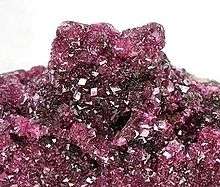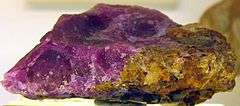Spherocobaltite
| Spherocobaltite | |
|---|---|
|
| |
| General | |
| Category | Carbonate mineral |
| Formula (repeating unit) | CoCO3 |
| Strunz classification | 5.AB.05 |
| Crystal system | Trigonal |
| Crystal class |
Hexagonal scalenohedral (3m) H-M symbol: (3 2/m) |
| Space group | R3c |
| Unit cell | a = 4.65, c = 14.95 [Å]; Z = 6 |
| Identification | |
| Formula mass | 118.94 g/mol |
| Color | Pink to red, brown, grey, velvet-black (surface alteration) |
| Crystal habit | Encrustations - forms crust-like aggregates on matrix, crystals uncommon: rhombohedral to discoidal |
| Cleavage | Perfect rhomboidal cleavage [1] |
| Mohs scale hardness | 4 |
| Luster | Vitreous |
| Streak | Pink |
| Diaphaneity | Transparent to translucent |
| Specific gravity | 4.13 |
| Optical properties | Uniaxial (–) |
| Refractive index | nε = 1.600, nω = 1.885 |
| Birefringence | 0.285 |
| Pleochroism | Dichroic: O = violet-red; E = rose-red |
| References | [1][2][3] |
Spherocobaltite or sphaerocobaltite is a cobalt carbonate mineral with chemical composition CoCO3. In its (rare) pure form, it is typically a rose-red color, but impure specimens can be shades of pink to pale brown. It crystallizes in the trigonal crystal system.
Discovery and occurrence
Spherocobaltite was first described in 1877 for an occurrence within cobalt and nickel veins in the St. Daniel Mine of the Schneeberg District, Erzgebirge, Saxony, Germany. The name is from the Greek "sphaira", sphere, and cobalt, in reference to its typical crystal habit and composition.[1] It occurs within hydrothermal cobalt-bearing mineral deposits as a rare phase associated with roselite, erythrite, annabergite and cobalt rich calcite and dolomite.[3]

Cluster of spherocobaltite crystals from the Katanga Copper Crescent, Katanga (Shaba), Democratic Republic of Congo (size: 11.5 x 6.0 x 4.5 cm)
References
Further reading
| Wikimedia Commons has media related to Spherocobaltite. |
This article is issued from
Wikipedia.
The text is licensed under Creative Commons - Attribution - Sharealike.
Additional terms may apply for the media files.
